The following link is to a Tweet from Peter Gleick regarding Typhoon Haiyan. It includes a map of the subsurface temperature anomalies at depths of 100 meters in the northwest tropical Pacific for October 2013. Overlaid on it is the storm track of Typhoon Haiyan. The map was included in Jeff Masters blog post here at the WeatherUnderground.
http://twitter.com/PeterGleick/status/400701313593270272/photo/1
The source of the map is the JMA webpage here. My figure 1 is the full map JMA presents for the depth of 100 meters. The JMA also presents temperature anomalies at 3 other depths: 50, 200 and 400 meters. Why didn’t Gleick and Masters present the temperatures at those depths as well?
Figure 1
I’ll let you decide. See Figures 2, 3 and 4.
Figure 2
###
Figure 3
###
Figure 4
And Figure 5 is the JMA map of sea SURFACE temperatures for October 2013.
Figure 5
Animation 1 is of the temperature anomaly maps at 100 meters from the JMA, from their start month in January 2011 to October 2013. The October 2013 conditions do not look “remarkable” when compared to the anomalies since January 2011.
Animation 1
Animation 2 is of the temperature anomaly maps at 100 50 meters from the JMA, from their start month in January 2011 to October 2013. The October map in the area of Haiyan doesn’t appear remarkable either.
Animation 2
Jeff Masters refers to Tropical Cyclone Heat Potential (TCHP) in his blog post, but fails to illustrate it. Animation 3 is an animation of Tropical Cyclone Heat Potential from NOAA here. At best, the Tropical Cyclone Heat Potential was low-to-mid scale at the time of Haiyan.
Animation 3
Now, I’m not disagreeing with Jeff Masters that a typhoon stirs subsurface waters and that the band of warm water at depths of 100 meters COULD have contributed to Haiyan. But Masters’s blog post was speculation. His use of the word “could” in his opening sentence is the indicator (my boldface).
A remarkable warming of the sub-surface Pacific waters east of the Philippines in recent decades, due to a shift in atmospheric circulation patterns and ocean currents that began in the early 1990s, could be responsible for the rapid intensification of Super Typhoon Haiyan.
Masters did not state the subsurface waters at depths of 100 meters WERE responsible, but “could be responsible”. He was speculating.
But Gleick presented it as fact, without showing that sea surface temperature anomalies and the temperature at 50 meters were not unusually warm.
One alarmist speculates and another presents it as fact. Why doesn’t this sound unusual to me?
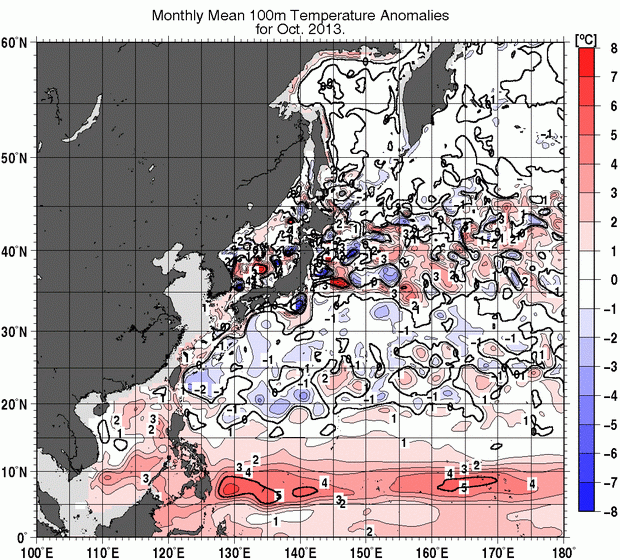
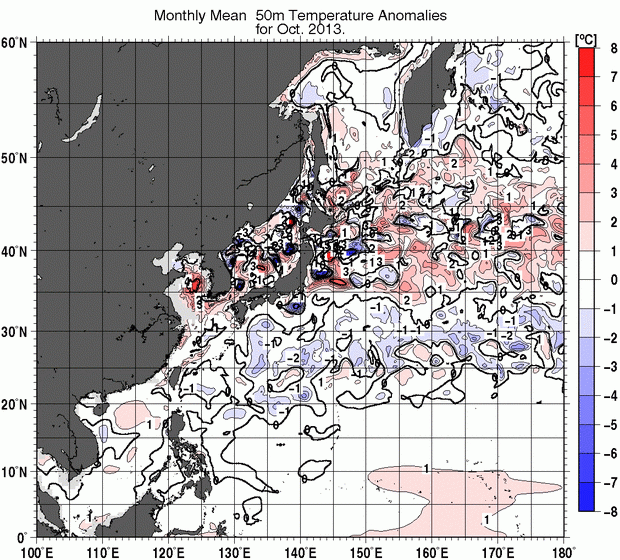
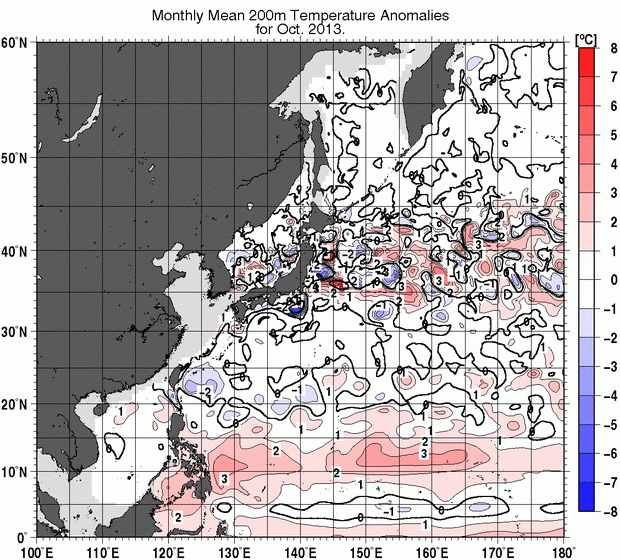
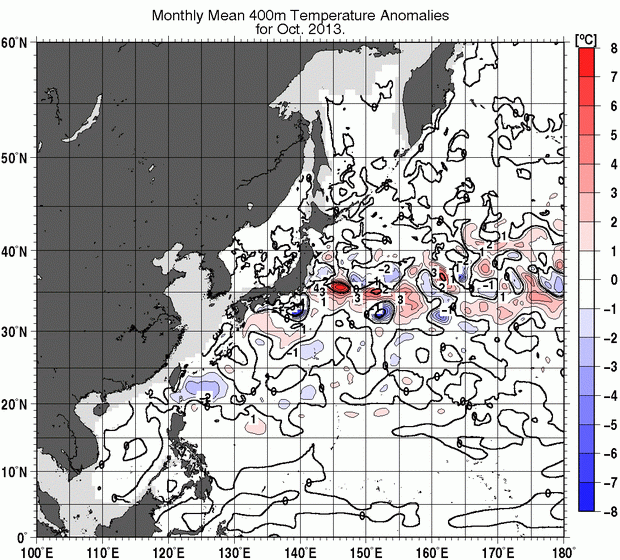

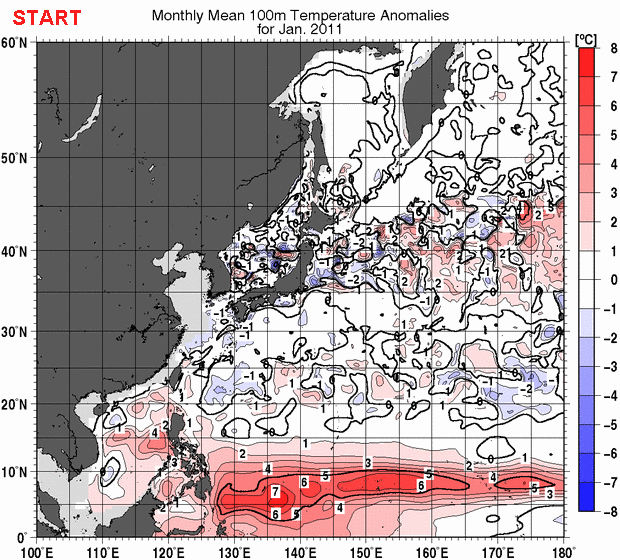
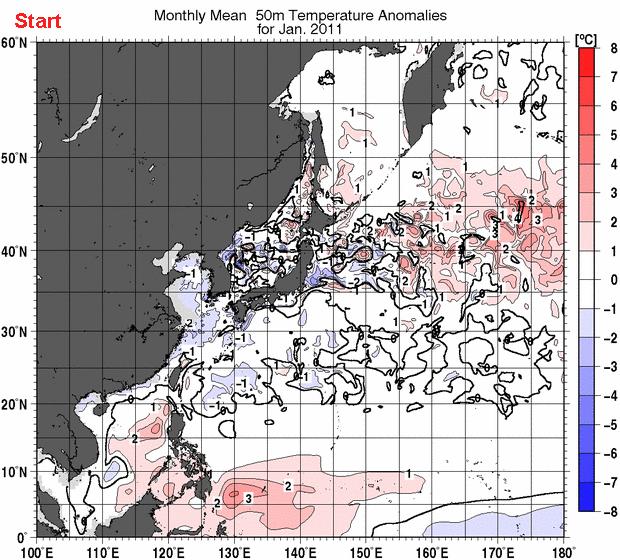
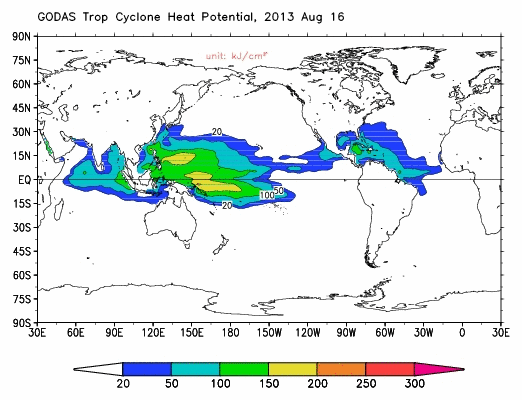
Gleick is just following his own lead. After all, his fraud was predicated on his belief that the Heartland “COULD” have written such a document, so he said they did.
One alarmist speculates and another presents it as fact. Why doesn’t this sound unusual to me?
Doesn’t sound unprecedented either.
modus operandi
Am not sure where Gleick said it did contribute to strengthening. Not that he didn’t say it. I just don’t see it. Was it in another tweet? He clearly mentioned the two events in the same sentence but I can’t see a cause and effect connector in the tweet you linked to.
Lovely maps. Look at all those vertical, horizontal and temporal temperature gradients. Calculating the Ocean Heat Content accurately must be a challenge.
That crook shouldn’t be doing anything except watchin’ the walls of his cell.
Does anyone actually think that cyclones do not draw on energy from deeper than a few meters?
Cyclone energy is on the order of megatons per minute. Do AGW fanatics think that cyclones have not always drawn on all the potential energy available?
It is mind boggling that it is even an issue.
This typhoon was not unique, not behaving in any sort of new way from the millions of years of cyclones that have occurred. AGW believers seem more and more to be the sort of people who would travel across the country to see the Blessed Mother in a tortilla.
Pamela Grey: “Am not sure where Gleick said it did contribute to strengthening…”
He implied it:
“Here is (HT to @wunderground) the abnormally high ocean temps and the track of Typhoon Haiyan.”
Never let a good tragedy go to waste.
hunter says: “Does anyone actually think that cyclones do not draw on energy from deeper than a few meters?”
My recall is that “they” say the top 60 meters have to be above 26 deg C in order to support a tropical cyclone. Otherwise the subsurface turbulence will mix too much cool subsurface water.
The difference between a scientist and an activist: a scientist surveys the trail of evidence and follows it to the cause; the activist follows the cause and gathers anecdotal evidence on the way.
hunter says:
November 14, 2013 at 5:45 am
Oh absolutely. However, it’s the surface temps that lead to storm formation, once the storm gets going wind can mix in the the water below. However, I have no idea how deep the mixed column can be. 100m seems too much in open ocean, I’ll defer to Ryan Maue for that answer.
The longer we keep records, the more likely those records will be broken. It doesn’t mean that nature is changing. It means we have been keeping records longer.
As a rule of thumb, a once in a lifetime storm can be expected once in a lifetime – AT YOUR LOCATION. If you only keep records for 10 years you are much less likely to see such a storm, than if you keep records for 100 years.
However, due to the nature of global communications, when a typhoon happens in PI, our minds make believe that we have “seen” the typhoon, so our minds create the illusion that typhoons are increasing. They are not increasing.
What is happening is that 100 years ago, you would have learned about the typhoon in PI only as a small article in page 6 of the newspaper. Now today, you learn about the typhoon on TV and the internet, as it happens, as though the storm was right outside your door threatening your house.
Did we have storms and bad weather before people started driving SUV’s? If not, then why did humans domesticate fire long before they learned to drive? Without fire humans would be still be confined to a narrow band of tropical rain forests along the equator. Everywhere else is too cold for us to survive for long otherwise.
In fact, the domestication of Fire is the only truly unique trait of human beings. And with fire comes CO2. So in many respects, the survival of the human race is directly tied to the production of CO2.
Joe Bastardi called Gleick or should that be gLIEck out on this on his Twitter page.
Gleick tried to push it as another sure sign of “climate change”
Seems these warminsta’s do not read IPCC reports ,where it states “no one weather event can be attributed to AGW”.
fred berple: “It doesn’t mean that nature is changing. It means we have been keeping records longer.”
Or changing how we measure things,
Nobody knows better how to commit perfectly legal fraud than Gleick.
Remember that not only Gleick, but almost our entire government today operates on the George Costanza principle: “It’s not a lie if you BELIEVE it to be true!”
TCHP methodology for new and old data.
http://www.aoml.noaa.gov/phod/cyclone/data/method.html
The words synthetic, linearly regressed, and interpolated stand out in version 2.1, which has been in use since 2008. Reminiscent of GISS data processing?
Misrepresentation is the evil twin of speculation.
Bob, where do the pre-ARGO subsurface temperature anomalies come from? On what baseline are they derived?
It seems to me that publishing such high spatial resolution anomalies when any data close to that resolution has only been around since 2005 is a flat out lie.
Slacko: Thanks. I corrected the typo.
scarletmacaw says: “Bob, where do the pre-ARGO subsurface temperature anomalies come from? On what baseline are they derived?”
Sorry. I don’t know enough about the JMA datasets to answer your question. The TAO project buoys have been in place since the early 1990s, but they only extend to about 9N and as far west as 135E.
Bob, you show anomalies in degrees C, but is a +2 at surface the same temp as a +2 at 100m – I don’t think so. In fact, the actual temp at 100m, if it were raised to surface would cool the surface and not contribute much to the hurricane, especially since the hurricane would have already passed by. This use of anomalies is bad enough for them being fictitious, but surely they are not very useful where we want comparative actual heat content. Anomalies are really an instrument of deception.
When engineers design a structure, they usually allow it to withstand a 100, 200, or 500 year weather event.
Although this cyclone was a tragedy, a similar one happens in the region every 100, 200, or 500 years.
As the whole global warming hoax starts winding down with the planet’s temperature refusing to co-operate and even the polar ice expanding, then in desperation the alarmists flail around seeking new ‘proof’, such as perfectly natural extreme weather events and supposed ocean acidification.
One simply cannot take an isolated short term event like the Philippines typhoon and blame it on global warming which is supposed to be a 30 year pattern to be valid . There is no long term pattern of warming SST in the Pacific as Bob previouly posted on an earlier track . There has been no warming in the Pacific for at least 20 years . So the warmist cannot take short term events and blame it on non existing long term global events . .
Tropical cyclones run on the heat of condensation, which is a function evaporation. I can guarantee that the water 100m down was not evaporating. The surface water temperature was close to average, as was the 50m water, and after Haiyan went by, it was probably below average because the storm mixed the naturally cooler water from below with the surface water.
Strong tropical cyclones naturally cool the surface water temperature through mixing, and one may argue that the warmer than average water 100m below the surface may have slowed that cooling by some tiny fraction, but that is likely irrelevant to the strength of Haiyan.
The limiting factor with most tropical cyclones in the heart of the tropical basins during season is not the amount of fuel (evaporating water from the surface), but the functioning of the rest of the heat engine. The atmosphere has to be just about perfect for something like Haiyan to develop, and that rarely occurs. But the ocean conditions required are almost always present in season. I am sure that if the water temperatures at 100m were also near average, there would have been no noticeable difference in the strength of Haiyan.
Jeff Masters should know better.
Bob, thank you for posting this. I saw that tweet earlier today and checked the Japanese site and quickly found out that the 50m anomalies were normal.
Maybe the fuss over global warming is all about money?
http://www.foxnews.com/world/2013/11/14/un-carbon-emissions-reduction-system-awash-in-cash-as-it-claims-to-face-hard/?intcmp=latestnews
Ex-ethics committee chairman Gleick is a self confessed liar and wire-fraudster.Why would anyone give any credence to what he says or be in the slightest bit surprised if he should continue to lie, cheat and misrepresent facts in order to ‘save the planet?
Bob and Ric, thanks for the replies. This entire line that Gleick the fraud and his pals are pursuing reminds me that the primitively religious see in any event proof of their deity at work. It boggles the mind that they are implying that cyclones have only started tapping warm waters in the age of CO2 obsession.
Gary Pearse says: “Bob, you show anomalies in degrees C, but is a +2 at surface the same temp as a +2 at 100m….”
Gary, the subsurface temperatures (absolute) at 100 meters were still in the 26+ deg C range.
http://www.data.kishou.go.jp/kaiyou/db/kaikyo/monthly/subt_wnp.html
Keep in mind the subsurface temperatures in the western tropical Pacific are normally elevated. The trade winds pile up the warm water there.
Records are nothing more (or less) than humans documenting the extreme variability of mother nature.
First off, these maps are ones of Anomalies. But of WHAT?
What is the baseline, and how well do we know it?
What is the uncertainty of the 100 m map?
Is it the Anomaly at 50, 100, 200, 400 meter surface slice?
Or are the maps the anomalies of the 0-50 meters, 0-100 meters, 0-200 meters, and 0-400 meters average temp interval slices? If you want to make connections to hurricanes, then you have to employ heat content and you cannot do that with just a thin surface, but with an interval of significant thickness. So what are the maps? a thin surface intersection of a bunch of ARGO profiles, or some average temp of an interval thickness with real heat content?
Again I ask, what is the baseline? Ok suppose there is a 4 deg C anomaly at 100 meters deep at some lat-long in the Pacific What is the baseline temperature? If the baseline at 100 meters is 20 deg C, then a 4 deg rise to 24 deg C is hardly fuel for a hurricane. Absolute temperatures matter.
Ok. I get the main point that the 50 meter map is no explanation for the cause of the hurricane, looking so much “cooler” than the 100 meter maps cherry-picked in the tweet. Anything tweeted by Peter Glick has another strike against it as a matter of Bayesian prior probabilities.
But it is possible to read this data in such a way that
1) 0-50 meters is Average – hot enough to breed hurricanes and typhoons as is historically common.
2) 50-100 meters is abnormally warm, which will remove the negative feedback cooling element of Cat 3 hurricanes that stir up deeper colder water to the warmer surface. If there is a 100 meter warmer anomaly, then it is possible that the negative feedback is reduced and a Cat 3 can more easily grow into a Cat 4. It all depends upon what ABSOLUTE temperatures are available in the various interval layers.
I’ve been thinking about what makes the warmist-skeptic fight go on and on. What I have noted is the constant difference in how each side places its emphasis, and that this shows up in its speech. Specifically, the skeptics use declarative, as in “this will”, “this shall” or “this does”, and, of course, its negative equals. The warmists use conditionals, i.e. words like “could” or “should” or “may” or “might” that indicate undefined probabilities and, in truth, possibilities, things that are determinable only after the fact.
The use of conditionals after 25 years is remarkable (here I make a declarative statement). Despite all the models and claims of correlation/matching of observation, we still have no “does”, “shall” or “will” in the IPCC or other CAGW programme. The dangers and fears are in the distant future, discussed only as emerging from the present, but still only becoming obvious in some, never-close-to-today,tomorrow.
This is not an academic situation. The human world acts on what it thinks, and it thinks through words. If the words are confusing, its thoughts are confused and its actions are not necessarily the best. The Mainstream Media (MSM) is particularly prone to confusion from the way they are instructed, and prone to confusing the readership by the way they combine emotional response with a misunderstanding of what the use of conditionals in a discussion means. The MSM think conditionals represent scientific caution, but what they represent is scientific uncertainty. The extent to which they are used represents the consideration of the likelihood that what they think “will” come, actually comes.
From what I see, there are four different types of (Un)Certainty involved in the CAGW narrative: 1) Computational, 2) Emotional and 3) Representational and 4) Ideological. (There may be more, or more subtle versions of these, but these 4 are probably close to the general breakdown.)
The IPCC 95% type is Computational Certainty, that is the outcome as proposed by models is consistent with input data and mathematical relationships between identified factors. McKibben’s certainty is based in Computational Certainty, as in “Do The Math”. It could also be labelled “Intellectual” Certainty, as it is based on the idea that nature is deterministic enough, and we are smart enough and knowledgeable enough to figure out what is going on in a usefully predictive way. The application of the argument by ignorance is applicable to this form of certainty: if we can’t think there is another way, then it must be the way we say. While naively reasonable, and a reflection of the arguments Sherlock Holmes was claimed to use in solving crimes, how it is used by the IPCC adherents is actually a perverse misuse of what Holmes did: Holmes used the concept to bring to the table non-current, usually non-obvious solutions, which would be then investigated closely. The IPCC cabal use it to dismiss the non-current and non-obvious).
The second type, the Emotional Certainty, is what roots Gore, the IPCC Summary and the 97% Consensus concept. With Emotional Certainty, the statements say that we are personally comfortable with the work done and where it ended – with the understanding that not everything could be done, but we believe to be the most important parts were covered. Outside the workers themselves, this comfort derives from authority, the trust in credibility of certain socially recognized individuals or groups. The MSM in particular seizes on this particular form of Certainty (regardless of how they, themselves, perceive it). Anyone connected with the IPCC is credible, therefore I am comfortable with what they say. Personal investigation in this regard is unnecessary, and indeed is a “skeptical” activity for those still not convinced, as it suggests a “better” understanding can exist outside what one gleans from just the Summary remarks. The notable history of a President misleading America about the reasons for going to war, or a Bernie Madoff misleading investors as to what was happening to their money makes no impact on the credibility of other parties: that was then, this is now (and these ones).
Ideological Certainty is what drives the eco-green. Greenpeace, the Sierra Club, Maurice Strong, David Suzuki, Friends of the Earth, the Waterkeepers, opponents of the XL Keystone pipeline: the arguments for CAGW are mere backups for other, anti-capitalist, anti-consumerist, pro-nature beliefs. This is not to say that those other beliefs are not valid, only that the principle position is not CO2-based warming per se. With Ideological Certainty, the certainty is that continuing the path we are on, the status quo, will cause socio- and environmental damage that is unacceptable (and may be catastrophic). The devil is in the general, not the detail: if we continue to consume and destroy – and fossil fuels are a fundamental part in this activity – the bad things will happen. Arguments about actual temperature sensitivity are not relevant. Whether we will experience 4 degrees or 1 degree warming by 2100, our societies are still on the road to ruin. It is this movement that must be stopped.
The fourth type of Certainty is Representational, in which what is projected is compared to what, at an initial state, is observed. This is where the skeptical position focuses. The skeptic wants to know the detail of what IS to happen and so looks to what HAS happened as a true indication (by pattern or observation) of how closely a predicted outcome has been matched by actual outcome. He does this so that he may respond – as he would say – “appropriately”.
The skeptic recognizes that responses are, and should be, proportional to the triggering event: a minor problem should not have elicited a large preventative measure if a small one would have sufficed. Energy – emotional, physical, social – is liimited and should be used wisely and sparingly if possible. To determine the details and hence the level of action that is appropriate, of course, one needs facts. And facts are not determined in policy summaries but in the field and the laboratory. Facts are not nailed down by consensus, i.e. group opinion, but by falsifiable testing. The skeptic, in his hunt for facts, is forced to read and question. Arguably having this desire for Representational Certainty is where the various skeptics or luke-warmers like Pielke, Lindzen, Watts and ourselves come in.
It should be noted that not all anti-CAGW narrative is driven simply by a desire for Representational Certainty before we act. Ideology, emotion and a narrow but intense trust in intellectual work also drive some skeptics. Certainly CFACT, Morano, the GWPF are seen in the eyes of warmists to be not just attacking the facts of the CAGW story, but the spirit: the obstructionism against CO2 reduction is perceived as anti-regulatory, pro-free market, pro-energy industry sentiments. Which, to some extent, is true. But all of us determine the course of our lives and support on the basis of multiple pulls and pushes, motivating factors that shift through time.
What makes the CAGW fight persist, IMHO, is that we argue about “Certainty” as if we are dealing with the same thing and each side is either foolish, perverse, or a paid shill not to recognize what each side holds. What I am saying in the above essay, is that we are not dealing with the same thing. I have listed four different aspects that lead to the decisions we make on supporting or not supporting CO2-related initiatives. The technical, dictionary-defined words are the same, but we argue because we are not using the same mental vocabulary.
Gleick should know better. He is a water expert and lectures on climate issues after all.
http://www.pacinst.org/about-us/staff-and-board/dr-peter-h-gleick/
What will interesting is to find out what the temps in the equivalent area are after the storm passes.
@Doug Proctor
What I have noted is the constant difference in how each side places its emphasis, and that this shows up in its speech.
No argument there.
Specifically, the skeptics use declarative, as in “this will”, “this shall” or “this does”, and, of course, its negative equals. The warmists use conditionals, i.e. words like “could” or “should” or “may” or “might” that indicate undefined probabilities and, in truth,
I am not so sure of this.
I’ll give you the warmists’ “could”, “may”, “might”, in so far as these are logical results from a post-normal Decide-Now-Before-We-Have-Adequate-Data menntality.
Skeptics are about multiple working hypotheses and alternatives. Skeptics are not afraid to use the words “could”, “may”, “might”, but to use them explicitly in describing alternatives. Better yet, describe uncertainty with some degree of precision.
Perhaps a bigger difference between warmists and skeptics is not in the use of words, but punctuation. From my observation, skeptics are more likely than warmists to use the question mark.
Warmist: “The world could end tomorrow.”
Skeptic: “Yes, it could. But, it isn’t very likely, is it? The world has seen an unbroken string of trillion dawns. Why should it stop now?”
A simple question.
What has more impact on hurricane intensification:
-the top 50m of the water column or water at 100m
Perhaps someone could explain in more detail how upwelling occurs with tropical cyclones. It is certainly more than the physics of wave action at depth, no?
Thanks, Bob. A very good post.
I was not surprised to see Master’s post earlier today, he hangs on every branch on the way down. I’m not bothering to mention his source.
Great post! Reveals blatant cherry pickers! The whole typhoon focus is cherry-pickng to divert attention from the lack of Atlantic hurricanes and the low ACE index.
Stephen Rasey says: “First off, these maps are ones of Anomalies. But of WHAT?”
Here’s the English translation/version from the JMA webpage:
“This figure is the average year and water temperature difference of the monthly average 50m depth of the northwest Pacific Ocean, 100m, 200m, the 400m. Normal value is the average of 2008-1986. Average year and water temperature difference, are color-coded scale to the right of the figure. The waters are shallow seabed 50m, 100m, 200m, from 400m, I are shown in light gray.”
Doug Proctor, great comment. I’m glad Anthony turned it into a post.
Regards
Thanks Bob for this post
Facts? We don’ need no stinkin’ facts!
It was a fact that it was a speculation, which chinese whispers makes a fact. Ideologues always preferred to communicate in chinese whispers.
More magically teleported heat? 100 meter water warms air without affecting 50 meter or surface water. Awesome.
Cool maps and animations Bob. Shows the interlacing nature of currents you have point out to me that exist on and below the ocean surface. Sometimes warm currents ride on top, and sometimes they flow along under a colder surface. What an interesting planet we live on. Gleick needs to say “hmmmmmmm” more often instead of motor mouthing his way through life.
Here is another CBC parrot, Bob McDonald of Quirks and Quarks passing Jeff Masters hypothesis as his own:
http://www.cbc.ca/newsblogs/technology/quirks-quarks-blog/2013/11/typhoon-haiyan-sign-of-whats-to-come-with-climate-change.html
He is not a one contradiction:
“The devastation in the Philippines from the strongest storm to ever hit land is a reminder of things to come, as storms gather strength on a warming planet.”
Then later:
” Haiyan is not the strongest storm ever recorded, but its impact was devastating because it tracked directly over the densely populated Philippines.”
And this bottom feeder is morally bankrupt enough to use victims for his own little crusade…
“Sadly, carbon dioxide levels continue to rise worldwide, as many countries – including Canada – fail to meet their emissions targets. Perhaps the images of those who have lost everything in the Philippines will put a human face on what is to come, as tropical storms gain more strength in the future and bring their wrath to those who are least responsible for climate change – but stand to suffer the most from the consequences.”
And that guy is paid by our tax dollars!
The animations here reminded me of a WUWT thread a few months back about ocean whirlpools. Couldn’t these provide a mechanism for transporting heat vertically during a typhoon?
See South Pacific and counter-clockwise eddies bearing west (same as the 100 m animation above) at 1:10 into video.
That happens pretty frequently on both sides of the debate.
hunter says:
November 14, 2013 at 5:45 am
Tropical storms may certainly draw on energy deeper than “a few meters” once they’ve formed, but the certainly don’t form (or draw on) the anomalies of a even a month-long series. They are an instant phenomenon based on instant conditions. They simply don’t have any capacity to care what the past or future holds, to say otherwise is anthropomorphisation or the sort of magical thinking that leads idiots to say that the denial creates the reality.